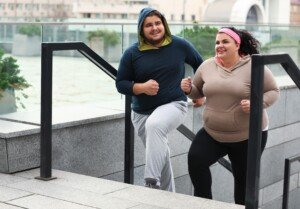
If you’re obese and want to do HIIT, it’s wise to have medical tests for clearance, as you may have a problem you’re not aware of.
Obesity, in and of itself, does not contraindicate high intensity interval training (HIIT).
This is because HIIT does not require fast, high impact movement, even though the work intervals are sometimes referred to as “sprint” intervals.
A sprint interval could be a very slow walk on a high treadmill incline (hands off the machine!), while the rest interval could be the same speed walk at zero incline.
You’ve probably read at some point in your life that before beginning an exercise program, to first get a physician’s clearance.
The word “clearance” is a little misleading, even though it’s in the title of my article. It’s a term that most people can easily relate to.
The truth is that all doctors want their patients to do some form of exercise.
The issue is the TYPE of activity.
For example, people with osteoporosis (brittle bones) shouldn’t perform isometric exercises.
Hip replacement patients are barred from certain positions and movements.
Patients with chronic obstructive pulmonary disease have their unique set of rules.
So do those with certain heart conditions and non-retractable low back problems.
What about obesity?
But what if your only condition is obesity, and you’re convinced you don’t have anything else wrong?
What if you’re brand new to exercise and have no idea how your body would handle HIIT?
Though the medical establishment indeed recommends a physical examination to clear you for exercise, keep in mind that a routine physical will uncover diabetes and high blood pressure very easily.
It’s also possible that the primary care physician could pick up a suspicious sound to your heartbeat through a stethoscope and then suggest you follow up with a cardiologist.
The primary care doctor will ask you questions when you announce you want to be cleared for HIIT.
Of course, your doctor may not know what high intensity interval training encompasses, so you’ll need to explain it.
You may be asked if you have knee, foot and hip pain. You should ask the physician to give your joints, especially your knees, an examination, says Carolyn Dean, MD, ND, Medical Advisory Board Member, Nutritional Magnesium Association at nutritionalmagnesium.org.
Dr. Dean also recommends a cardiac stress test. For peace of mind, the obese person who wants to feel secure doing HIIT workouts should book an appointment with a cardiologist.
You will then have a heart specialist listening to your heart with a stethoscope. You’ll also get an EKG, which can reveal a lot.
For a more in-depth look into your heart health, you should request the cardiac stress test, which will measure your heart’s blood flow during physical exertion, which can be done on a treadmill or stationary bike.
If you plan on doing your high intensity interval training sessions on a treadmill or bike, choose whichever one it is for your heart stress test.
If all of your tests come back negative, you will have great peace of mind and feel confident about pursuing HIIT exercise, despite being obese.

Dr. Dean, in practice for 35+ years and author of “The Magnesium Miracle,” is also a naturopath, nutritionist, herbalist, acupuncturist, lecturer and consultant.
 Lorra Garrick has been covering medical, fitness and cybersecurity topics for many years, having written thousands of articles for print magazines and websites, including as a ghostwriter. She’s also a former ACE-certified personal trainer.
Lorra Garrick has been covering medical, fitness and cybersecurity topics for many years, having written thousands of articles for print magazines and websites, including as a ghostwriter. She’s also a former ACE-certified personal trainer.
.









































